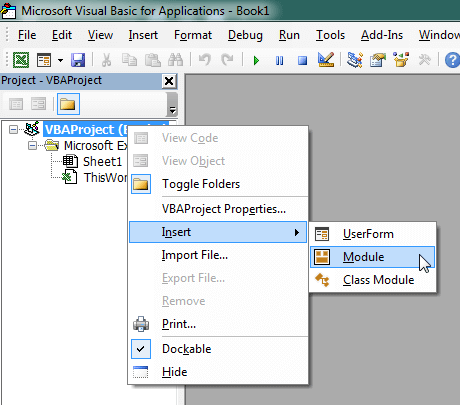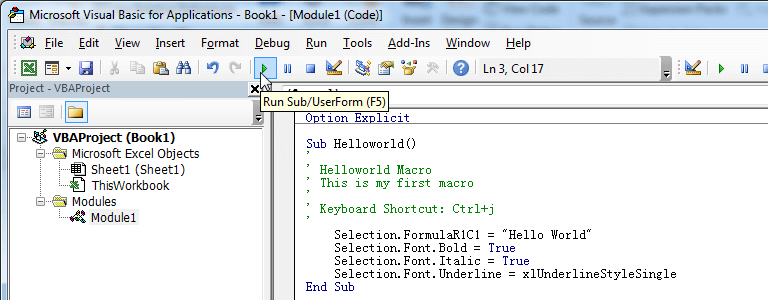This Excel macro can list files in a specified folder and subfolders, and you can filter multiple file types. The difference from the previous macro (See: Excel Macro: List All Files in Folders and Subfolders) is that you can get more file information, such as video duration/length.

List Files in Folders and Subfolders
This is a Nested-Function, you need call this function in a Sub procedure. Note that this macro only lists "MKV", "AVI", "MP4" files, you can change to yours.
Sub GetFilesInFolder(FolderPath As String, GetSubfolders As Boolean)
' For Example: GetFilesInFolder("D:\YourFolderName", True)
' Url: https://excelbaby.com/learn/excel-macro-list-files-in-subfolders-version-2/
Dim FSO As Object, objFolder As Object
Dim SubFolder, FileItem
Dim LastBlankCell As Long
Set FSO = CreateObject("Scripting.FileSystemObject")
Set objFolder = FSO.GetFolder(FolderPath)
Application.ScreenUpdating = False 'Disable Screen Updating to speed up macro
LastBlankCell = Cells(Rows.Count, 1).End(xlUp).Row + 1 'Get the last blank cell of column A
' Table header
If LastBlankCell = 2 Then
Range("A1:L1").Value = Array("#", "Name", "Base Name", "Attributes", "Path", "Size", _
"Type", "Extension", "Date Created", "Date Last Accessed", "Date Last Modified", "Length")
End If
' Main loop
For Each FileItem In objFolder.Files
FileExtension = UCase(FSO.GetExtensionName(FileItem.Name)) 'Get file extension
Select Case FileExtension
Case "MKV", "AVI", "MP4" 'Get "MKV", "AVI", "MP4" files
Cells(LastBlankCell, 1) = LastBlankCell - 1 '#
Cells(LastBlankCell, 2) = FileItem.Name 'Name
Cells(LastBlankCell, 3) = FSO.GetBaseName(FileItem.Name) 'Base Name
Cells(LastBlankCell, 4) = FileItem.Attributes 'Attributes
Cells(LastBlankCell, 5) = FileItem.path 'Path
Cells(LastBlankCell, 6) = FileItem.Size 'Size
Cells(LastBlankCell, 7) = FileItem.Type 'Type
Cells(LastBlankCell, 8) = FileExtension 'Extension
Cells(LastBlankCell, 9) = FileItem.DateCreated 'Date Created
Cells(LastBlankCell, 10) = FileItem.DateLastAccessed 'Date Last Accessed
Cells(LastBlankCell, 11) = FileItem.DateLastModified 'Date Last Modified
Cells(LastBlankCell, 12) = GetFileDetails(FileItem, 27) 'Length
LastBlankCell = LastBlankCell + 1 'next row number
Case Else
End Select
Next FileItem
' Get the Files of Subfolders. This is a Nested-Function Calling.
If GetSubfolders = True Then
For Each SubFolder In objFolder.Subfolders
GetFilesInFolder SubFolder.path, True
Next SubFolder
End If
Set objFolder = Nothing
Set FSO = Nothing
' Cells.EntireColumn.AutoFit
Application.ScreenUpdating = True
End Sub
Public Function GetFileDetails(ByVal FileItem As Object, ByVal iColumn As Integer) As Variant
Dim objShell, objFolder, objFolderItem
Set objShell = CreateObject("Shell.Application")
Set objFolder = objShell.Namespace(FileItem.ParentFolder.path)
Set objFolderItem = objFolder.ParseName(FileItem.Name)
GetFileDetails = objFolder.GetDetailsOf(objFolderItem, iColumn) 'Video length, iColumn=27
Set objShell = Nothing
Set objFolder = Nothing
Set objFolderItem = Nothing
End FunctionHow to use this macro
You need creat a sub, and call the GetFilesInFolder procedure. The GetFilesInFolder procedure has two arguments:
- The
FolderPathargument:String, Specify the file directory you want to list, Eg."D:\MyWorkbook". - The
GetSubfoldersparameter:Boolean,TrueorFalse, if you want to list subfolders, set it toTrue, otherwise set it toFalse.
For example: Get the folder "D:\Excel Functions" and subfolders file information:
Sub RunThisMacroToTest()
GetFilesInFolder "D:\Excel Functions", True 'call GetFilesInFolder sub
End SubDon't get subfolders:
Sub RunThisMacroToTest()
GetFilesInFolder "D:\Excel Functions", False 'call GetFilesInFolder sub
End SubExamples
Add more file information in new columns
For example, if you want to add Authors to a new column:
- Add the
Authorsto the array (line 18-19), and replaceRange("A1:L1").ValuetoRange("A1:N1").Value:Range("A1:N1").Value = Array("#", "Name", "Base Name", "Attributes", "Path", "Size", _ "Type", "Extension", "Date Created", "Date Last Accessed", "Date Last Modified", "Length", "Authors") - In the main loop, line 40, add the code to get the
Authorsdetails.Cells(LastBlankCell, 13) = GetFileDetails(FileItem, 20) 'Authors
The following table shows the commonly used parameters of the GetDetailsOf method, the index number of Authors in the table is 20.
| Item Name | Index Number |
|---|---|
| Name | 0 |
| Size | 1 |
| Item type | 2 |
| Date modified | 3 |
| Date created | 4 |
| Date accessed | 5 |
| Attributes | 6 |
| Offline status | 7 |
| Availability | 8 |
| Perceived type | 9 |
| Owner | 10 |
| Kind | 11 |
| Date taken | 12 |
| Contributing artists | 13 |
| Album | 14 |
| Year | 15 |
| Genre | 16 |
| Conductors | 17 |
| Tags | 18 |
| Rating | 19 |
| Authors | 20 |
| Title | 21 |
| Subject | 22 |
| Categories | 23 |
| Comments | 24 |
| Copyright | 25 |
| # | 26 |
| Length | 27 |
| Bit rate | 28 |
| Protected | 29 |
| Camera model | 30 |
| Dimensions | 31 |
| Camera maker | 32 |
| Company | 33 |
| File description | 34 |
| Masters keywords | 35 |
You can get the content of this table by running the following macro, of course you can also change the parameters to get more, Eg. change 35 to 100.
Sub GetItemName()
'Get the Item Name and Index Number, used for GetDetailsOf
Sheets.Add 'Add a new worksheet
Dim objShell, objFolder
Set objShell = CreateObject("Shell.Application")
Set objFolder = objShell.Namespace("C:\")
For i = 0 To 35 'You can change 35 to biger number
Cells(i + 1, 1) = objFolder.GetDetailsOf(objFolder.Items, i) 'Item name
Cells(i + 1, 2) = i 'Index Number
Next
End SubGet all files information
If you don't need to filter specific file types and you want to get all files, just comment Select Case, replace line 26 to 44 with below code:
' Select Case FileExtension
' Case "MKV", "AVI", "MP4" 'Get "MKV", "AVI", "MP4" files
Cells(LastBlankCell, 1) = LastBlankCell - 1 '#
Cells(LastBlankCell, 2) = FileItem.Name 'Name
Cells(LastBlankCell, 3) = FSO.GetBaseName(FileItem.Name) 'Base Name
Cells(LastBlankCell, 4) = FileItem.Attributes 'Attributes
Cells(LastBlankCell, 5) = FileItem.path 'Path
Cells(LastBlankCell, 6) = FileItem.Size 'Size
Cells(LastBlankCell, 7) = FileItem.Type 'Type
Cells(LastBlankCell, 8) = FileExtension 'Extension
Cells(LastBlankCell, 9) = FileItem.DateCreated 'Date Created
Cells(LastBlankCell, 10) = FileItem.DateLastAccessed 'Date Last Accessed
Cells(LastBlankCell, 11) = FileItem.DateLastModified 'Date Last Modified
Cells(LastBlankCell, 12) = GetFileDetails(FileItem, 27) 'Length
LastBlankCell = LastBlankCell + 1 'next row number
' Case Else
'
' End SelectGet specific file types
This macro only lists "MKV", "AVI", "MP4" files, what if you want to list "XLS", "XLSX" file types? Just replace line 27 with below code:
Case "XLS", "XLSX" 'Get "XLS", "XLSX" filesChange filter
If you want to filter by file size, e.g. list files larger than 5Mb (5Mb = 5*1024*1024 = 5242880 bytes)?
First, you need to define a variable, named FileSize, then using Select Case statements or If...Then...Else statements to determine the file size, replace line 22 to 45 with following code:
' Main loop
Dim FileSize As LongLong
For Each FileItem In objFolder.Files
FileExtension = UCase(FSO.GetExtensionName(FileItem.Name)) 'Get file extension
FileSize = FileItem.Size
Select Case FileSize
Case Is > 5242880 'file size > 5Mb
Cells(LastBlankCell, 1) = LastBlankCell - 1 '#
Cells(LastBlankCell, 2) = FileItem.Name 'Name
Cells(LastBlankCell, 3) = FSO.GetBaseName(FileItem.Name) 'Base Name
Cells(LastBlankCell, 4) = FileItem.Attributes 'Attributes
Cells(LastBlankCell, 5) = FileItem.path 'Path
Cells(LastBlankCell, 6) = FileItem.Size 'Size
Cells(LastBlankCell, 7) = FileItem.Type 'Type
Cells(LastBlankCell, 8) = FileExtension 'Extension
Cells(LastBlankCell, 9) = FileItem.DateCreated 'Date Created
Cells(LastBlankCell, 10) = FileItem.DateLastAccessed 'Date Last Accessed
Cells(LastBlankCell, 11) = FileItem.DateLastModified 'Date Last Modified
Cells(LastBlankCell, 12) = GetFileDetails(FileItem, 27) 'Length
LastBlankCell = LastBlankCell + 1 'next row number
Case Else
End Select
Next FileItemAny more?
Yes!
For example: If you want to move the list file to a new folder, just add the following code to line 40:
FSO.MoveFile FileItem.path, "D:\My Favorites\Video\"For example: what if you wanted the user to select a folder from a dialog instead of entering a specific folder? The following macro will help you.
Sub RunThisMacroToTest()
'Select a folder to list file information
Dim FolderPicker As FileDialog
Dim myFolder As String
'Select Folder with Dialog Box
Set FolderPicker = Application.FileDialog(msoFileDialogFolderPicker)
With FolderPicker
.Title = "Select A Single Folder"
.AllowMultiSelect = False
If .Show <> -1 Then 'Check if user clicked cancel button
Exit Sub
Else
GetFilesInFolder .SelectedItems(1), True 'call GetFilesInFolder sub
End If
End With
End SubFor example: if you want to add a hyperlink to open the file, add the following code to line 40:
Cells(LastBlankCell, 13) = "=HYPERLINK(""" & FileItem.path & """,""" & "Open" & """)" 'HyperlinkHow to Use This Macro
Most VBA code should be placed in Standard Modules unless specified.
If you see a comment '------------------ Modules------------------ in the code header that means put the code in a Standard Module. For more information, learn this course: Where should I put the Excel VBA code?
The following steps teach you how to put VBA code into a Standard Module:
- Activate the Visual Basic Editor by pressing ALT + F11.
- Right-click the project/workbook name in the Project Window.
- Choose Insert -> Module.

- Type or paste the code in the newly created module. You will probably need to change the sheet name, the range address, and the save location.

- Click Run button on the Visual Basic Editor toolbar.

- For more information, learn this course: Programming with Excel VBA